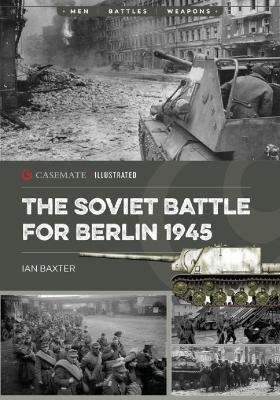
The soviet battle for Berlin 1945
Seiten
2024
|
1. Auflage
Casemate Publishers (Verlag)
978-1-63624-437-2 (ISBN)
Casemate Publishers (Verlag)
978-1-63624-437-2 (ISBN)
A fully illustrated account of the final battle for Berlin.
In the spring of 1945, simultaneously with the battle of the Seelow Heights, powerful Red Army spearheads launched three sub-offensive operations to clear German resistance for the Berlin operation. Between April 13 and 17, 1945, elements of the 2nd Belorussian Front replaced parts of the 1st Belorussian Front and began to prepare their offensive operations. Bitter fighting ensued, as German units desperately tried to hold their positions. Whilst these operations continued with unabated ferocity, Zhukov’s 1st Belorussian Front broke through the final line of the Seelow Heights and nothing but broken German formations lay between them and Berlin.
On April 20, Hitler’s 56th birthday, Soviet artillery of the 1st Belorussian Front began shelling Berlin in preparation for attacking the city. At the same time the 1st Belorussian Front advanced towards the east and northeast of the Reich capital, whilst the 1st Ukrainian Front smashed through the last formations of the northern wing of the German Army Group Center. What followed was the Soviet battle for Berlin. Russian planners divided the frontal and pincer parts of the battle for Berlin in phases. Once the 1st Belorussian Front and 1st Ukrainian Front completely encircled the city, over one million Russian soldiers began attacking into the suburbs towards the center. They faced some 45,000 soldiers in several severely depleted Wehrmacht and Waffen-SS divisions. These divisions were supplemented by the Berlin Police force, and the Hitlerjugend and Volkssturm, mainly manned by teenaged boys.
In the spring of 1945, simultaneously with the battle of the Seelow Heights, powerful Red Army spearheads launched three sub-offensive operations to clear German resistance for the Berlin operation. Between April 13 and 17, 1945, elements of the 2nd Belorussian Front replaced parts of the 1st Belorussian Front and began to prepare their offensive operations. Bitter fighting ensued, as German units desperately tried to hold their positions. Whilst these operations continued with unabated ferocity, Zhukov’s 1st Belorussian Front broke through the final line of the Seelow Heights and nothing but broken German formations lay between them and Berlin.
On April 20, Hitler’s 56th birthday, Soviet artillery of the 1st Belorussian Front began shelling Berlin in preparation for attacking the city. At the same time the 1st Belorussian Front advanced towards the east and northeast of the Reich capital, whilst the 1st Ukrainian Front smashed through the last formations of the northern wing of the German Army Group Center. What followed was the Soviet battle for Berlin. Russian planners divided the frontal and pincer parts of the battle for Berlin in phases. Once the 1st Belorussian Front and 1st Ukrainian Front completely encircled the city, over one million Russian soldiers began attacking into the suburbs towards the center. They faced some 45,000 soldiers in several severely depleted Wehrmacht and Waffen-SS divisions. These divisions were supplemented by the Berlin Police force, and the Hitlerjugend and Volkssturm, mainly manned by teenaged boys.
| Erscheinungsdatum | 20.11.2024 |
|---|---|
| Zusatzinfo | Illustrationen |
| Verlagsort | [Philadelphia] |
| Sprache | englisch |
| Maße | 152 x 229 mm |
| Themenwelt | Geschichte ► Allgemeine Geschichte ► 1918 bis 1945 |
| Geisteswissenschaften ► Geschichte ► Regional- / Ländergeschichte | |
| Geschichte ► Teilgebiete der Geschichte ► Militärgeschichte | |
| ISBN-10 | 1-63624-437-8 / 1636244378 |
| ISBN-13 | 978-1-63624-437-2 / 9781636244372 |
| Zustand | Neuware |
| Informationen gemäß Produktsicherheitsverordnung (GPSR) | |
| Haben Sie eine Frage zum Produkt? |
Mehr entdecken
aus dem Bereich
aus dem Bereich
ein Psychologe erlebt das Konzentrationslager
Buch | Hardcover (2024)
Kösel (Verlag)
CHF 30,80
Mythos „Stauffenberg-Attentat“ – wie der 20. Juli 1944 verklärt und …
Buch | Hardcover (2024)
Goldmann (Verlag)
CHF 33,55


